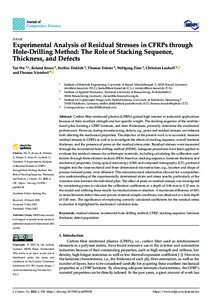| dc.date.accessioned | 2023-08-02T07:17:47Z | |
| dc.date.available | 2023-08-02T07:17:47Z | |
| dc.date.issued | 2023-05-09 | |
| dc.identifier | doi:10.17170/kobra-202308018549 | |
| dc.identifier.uri | http://hdl.handle.net/123456789/14961 | |
| dc.language.iso | eng | |
| dc.rights | Namensnennung 4.0 International | * |
| dc.rights.uri | http://creativecommons.org/licenses/by/4.0/ | * |
| dc.subject | residual stresses | eng |
| dc.subject | incremental hole-drilling method | eng |
| dc.subject | CFRP | eng |
| dc.subject | stacking sequence | eng |
| dc.subject | defect population | eng |
| dc.subject | laminate thickness | eng |
| dc.subject.ddc | 620 | |
| dc.title | Experimental Analysis of Residual Stresses in CFRPs through Hole-Drilling Method: The Role of Stacking Sequence, Thickness, and Defects | eng |
| dc.type | Aufsatz | |
| dcterms.abstract | Carbon fiber reinforced plastics (CFRPs) gained high interest in industrial applications because of their excellent strength and low specific weight. The stacking sequence of the unidirectional plies forming a CFRP laminate, and their thicknesses, primarily determine the mechanical performance. However, during manufacturing, defects, e.g., pores and residual stresses, are induced, both affecting the mechanical properties. The objective of the present work is to accurately measure residual stresses in CFRPs as well as to investigate the effects of stacking sequence, overall laminate thickness, and the presence of pores on the residual stress state. Residual stresses were measured through the incremental hole-drilling method (HDM). Adequate procedures have been applied to evaluate the residual stresses for orthotropic materials, including calculating the calibration coefficients through finite element analysis (FEA) based on stacking sequence, laminate thickness and mechanical properties. Using optical microscopy (OM) and computed tomography (CT), profound insights into the cross-sectional and three-dimensional microstructure, e.g., location and shape of process-induced pores, were obtained. This microstructural information allowed for a comprehensive understanding of the experimentally determined strain and stress results, particularly at the transition zone between the individual plies. The effect of pores on residual stresses was investigated by considering pores to calculate the calibration coefficients at a depth of 0.06 mm to 0.12 mm in the model and utilizing these results for residual stress evaluation. A maximum difference of 46% in stress between defect-free and porous material sample conditions was observed at a hole depth of 0.65 mm. The significance of employing correctly calculated coefficients for the residual stress evaluation is highlighted by mechanical validation tests. | eng |
| dcterms.accessRights | open access | |
| dcterms.creator | Wu, Tao | |
| dcterms.creator | Kruse, Roland | |
| dcterms.creator | Tinkloh, Steffen Rainer | |
| dcterms.creator | Tröster, Thomas | |
| dcterms.creator | Zinn, Wolfgang | |
| dcterms.creator | Lauhoff, Christian | |
| dcterms.creator | Niendorf, Thomas | |
| dcterms.extent | 21 Seiten | |
| dc.relation.doi | doi:10.3390/ jcs6050138 Academic Editor: | |
| dc.subject.swd | Kohlenstofffaserverstärkter Kunststoff | ger |
| dc.subject.swd | Eigenspannung | ger |
| dc.subject.swd | Laminat | ger |
| dc.subject.swd | Mechanische Eigenschaft | ger |
| dc.type.version | publishedVersion | |
| dcterms.source.identifier | eissn:2504-477X | |
| dcterms.source.issue | Issue 6 | |
| dcterms.source.journal | Journal of Composites Science | eng |
| dcterms.source.volume | Volume 5 | |
| kup.iskup | false | |
| dcterms.source.articlenumber | 138 | |


